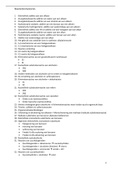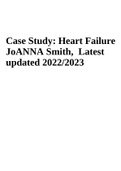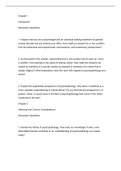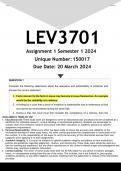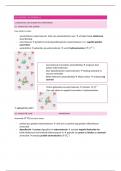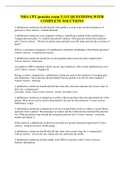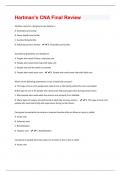Sophie Thompson-unit 5- Meeting individual care and support needs
Assignment 1 – Learning aim, A, B & C
Providing support for individuals in the community
Part 1
My name is Sophie Thompson and I have completed work experience in a community hospital. I have been providing
support for Valerie B and Billy G who are recovering from illness. These people are not ready to go home yet. To
demonstrate my understanding of the diverse care and support needs of each and how these can be met, I have been
asked to produce a set of case notes for both.
Equality mean that everyone has equal access and opportunities to all service needed. All individuals should receive care
of similar quality despite any difference factors. Individuals with different beliefs should have these respected. For
example, if a person religious beliefs mean they have certain dietary requirements or specific prayer times any service
provider should respect this. If these things aren't respected service users will feel undervalued and it might slow down
their recovery. 5A.P1
Diversity is the apperception of differences between people. To value diversity is to respect different cultures, beliefs,
and lifestyles. If you are unwilling to do this, you will be unable to understand them or meet their needs if you are caring
them. It is a legal requirement for service providers to respect and value all individuals despite their age, gender, and
disability. 5A.P1
Discrimination is when someone has a prejudice against a person against an individual or group. Discrimination can be
due to race, age, gender, religious beliefs etc. These individuals or groups are then treated differently due to their
differences. There are 4 types of discrimination unfair, direct, indirect, and positive. Unfair discrimination is when
someone is treated unfairly compared to another. Valerie has been a victim of this as she is being bullied by the local
teenagers due to her size, she has also been a victim of direct discrimination, which is when someone is rude or
offensive to an individual due to them being seen as different. The next type of discrimination is indirect discrimination
which when something seems like it isn't discrimination, but it is discriminatory. Positive discrimination is where a
decision is made in a person's favour because there is something different about them. 5A.P1
Discrimination can cause many effects on service users, so it is crucial to prevent discrimination, so that everyone
receives an equal quality of service. Some of the effects of discrimination on service users include stress, loss of
confidence, mental illness, loss of self-esteem and living in fear of others. This links to Valerie. Valerie was admitted to
hospital, following surgery for her burst appendix, the surgery was complicated due to her size, and she now doesn’t
want to return home due to the teenagers that are bulling her due to her obesity. This bulling affects her in a few ways,
Valerie is living in constant fear of other individuals even stopping her from going home in case it starts again this will
make her lack confidence within herself and cause low self-esteem. This discrimination can also cause her stress, as she
is constantly worried about the bulling. Due to this long-term stress, she could develop depression and anxiety on top of
her previous mental health problems due to her parents' death. 5A.P1
People are more likely to be discriminated against due to being disabled, which is any condition of the body or mind that
makes certain activities harder for the individual. To Discriminate against someone with a disability would be to limit
their access to services or general needs. Discrimination can be prevented for the disabled by having automatic doors for
wheelchair users, lifts, or larger parking spaces. However, these are not always effective. For the use of automatic doors,
,you need power so if there happens to be a power cut it will stop the doors from working and lifts are also suspectable
to breaking down. People in gay relationships are also more likely to be discriminated against. To discriminate someone
for being in a gay relationship would be taking away something or treating someone different because they are gay. This
is prevented by laws protecting gay people including the gay marriage rights. However, there are still things that are not
covered in any LGBT+ laws and these laws don’t stop all forms of discrimination. 5A.M1/5A. D1
The reason of promoting anti-discriminatory practice is to empower service users and to reduce a range of
discrimination and their potential effects on service users. There are initiatives that service providers use to prevent
discrimination, for example offering a person-centred approach. Offering a person- centred approach or personalised
care is an approach that explicitly acknowledges that people want to be treated as a whole person by professionals, for
example being involved in decisions about their health and care; be supported to actively manage their own health and
wellbeing, and for their care to feel coordinated. This decreases the chance of discrimination by enabling the service
providers to engage meaningfully with the service users, working in this way fosters a culture of respect and
compassion. A person-centred approach can greatly benefit Valerie and Billy as this approach places their needs and
preferences and goals at the forefront of their care. This promotes a sense of empowerment, dignity and autonomy,
ultimately leading to a more positive and effective service experience, which due to their unseen circumstances they
may feel out of control and confused but a person-centred approach can make them feel more in control with their care
leading them to take service providers advise and recovery quicker. However, this may not always be the case. A person-
centred approach may not work for Billy and Valerie if they feel unheard or if their preferences and needs are not fully
understood or respected. It's important for service providers to actively listen, show empathy and involve the service
user in decision making. If there is a lack of communication or collaboration, the approach may not effectively meet their
unique needs and goals, this will lead to Valerie and Billy feeling out of control and non- trusting of their care provider
causing a slower recovery. 5A.M1/5A. D1
To further prevent discrimination service providers, respect the individual's religion and beliefs. They do this by
respecting diet choices or prayer times. In healthcare diet choices are respected by acknowledging the individuals.
Preferences. Healthcare providers work collaboratively with patients to develop personalised dietary plans that align
with their goals and values. This includes considering cultural, religious, ethical and personal believes when making
recommendations. Respecting diet choices empowers individuals to take an active role in their own healthcare journey
and promotes a positive and inclusive approach to nutrition. For example, if someone follows a vegetarian or vegan diet,
health care providers would take that into consideration when making dietary recommendations. By involving
individuals in their decision-making process, healthcare providers can ensure that diet choices are respected and
integrated into their overall healthcare plan. This links to Valerie as she is a vegetarian so healthcare providers will have
to take this into account when recommending dietary changes due to her needing to lose weight. This will lead her to
Feeling more in control with her recovery. However, respecting dietary Choices is not always effective. For example, if
someone has severe allergies or medical conditions that require specific dietary restrictions, it may be necessary to
prioritise their health and safety over their personal preferences. It may not always align with their personal preference.
but it's essential for their overall health. This demonstrates that dietary restrictions are not always a choice. 5A.M1/5A.
D1
Another initiative that services providers use to prevent discrimination is the use of advocates. An advocate is a person
who publicly supports or recommends a particular cause or policy. In advocate in healthcare supports people in
expressing their views and wishes and help them stand-up for their rights if they are being mistreated. Billy may need an
advocate due to his life on the street. Billy may no longer have confidence to find support or even know where to go to
find help. Although he may find it difficult it is essential that he provide the correct information to get the most effective
care, however advocates may not be always available. Most of the time close family members like parents will take on
, the role of an advocate, however this can cause some issues with their child's care. For example, when parents act as
medical advocates, they may lack medical expertise and unintentionally make decisions that are not in the best interest
of their child's health, this can lead to further health problems and slower recovery. Another disadvantage of this is that
it can create conflict between the parents and healthcare providers, which can hinder effective communication and
collaboration, potentially impacting that quality of care for the patients. Another aspect to consider is the potential for
bias when parents act as medical advocates. Personal beliefs, values, and experiences can influence the decisions and
recommendations they make for the patients care. This can lead to a lack objectivity in the decision making and
potentially hinder the child's access to appropriate medical care. This is a big consequence if Billys mother was to act as
his advocate, due to their conflict it could cause bias within medical decision making, limiting Billys access to diverse
medical opinions and treatments. This shows that parents being advocates will not always best option and cause more
harm instead of helping the patient, which advocates are meant to do. Which means due to Billy’s circumstances limits
the effectiveness of advocates. 5A.M1/5A. D1
A further initiative used to prevent discrimination is the building on the service users' abilities also known as a strengths-
based practice, which is a collaborative process between the service users and service providers allowing them to work
together to determine an outcome that draws on the persons strengths. However, this may not always be the most
effective method. One limitation is that it may overlook underlying issues or barriers that individuals face. For example,
if someone is experienced significant mental health challenges or trauma, solely focusing on their strengths may not
adequately address their needs. In such cases, a more comprehensive approach that combines strength-based strategies
with targeted interventions may be necessary. Each person situation is unique and healthcare providers must be flexible
and adaptable in their approach to ensure the best possible outcomes for their patients. This type of practice links with
Valerie, due to her mental health conditions stemming from trauma, a strength-based practice with focus on
empowering her by recognising her existing strength and resilience. Rather than dwelling solely on the on her past
experiences and challenges, the healthcare provider will collaborate with her to develop a personalised treatment plan
that incorporates her strengths. This will help her regain a sense of control, build self-esteem and work towards positive
mental health outcomes. It emphasizes her ability to overcome adversity and fosters a more hopeful an empowering
perspective on recovery. However, a strengh based practise is not the most effective for Billy's as this practise often
overlooks underlying barriers, like being homeless. While it is important to recognise Billie strengths. Addressing
immediate needs such as housing and access to basic resources becomes a top priority. This means that billie's recovery
plan will need interventions that address his housing and Socioeconomic challenges, which will provide a more
comprehensive support to improve his mental health and overall wellbeing. 5A.M1/5A. D1
Part 2
When working in healthcare to provide the most effective care many skills and attributes are needed. Skills are what you
develop as you grow, this includes the ability to analyse and critically evaluate information, communicate effectively
with individuals and groups. Also be able to produce accurate records and make informed decisions. Personal attributes
refer to personal qualities or characteristics that a person has such as being caring, honest and patient.
Care is when you feel concern or responsibility for someone. Care involves looking after someone. Care can also involve
listening to an individual's wishes and being respectful of their beliefs and taking this in to account when caring for
them. Valerie has mental health issues and has low self-esteem. In addition to this she is being bullied by people where
she lives. Due these factors when caring for her it is best to use a warm, comforting and supporting approach, this may
help her feel a sense of relief from what she is used to at home. On the other hand, caring for Valerie may include having
Assignment 1 – Learning aim, A, B & C
Providing support for individuals in the community
Part 1
My name is Sophie Thompson and I have completed work experience in a community hospital. I have been providing
support for Valerie B and Billy G who are recovering from illness. These people are not ready to go home yet. To
demonstrate my understanding of the diverse care and support needs of each and how these can be met, I have been
asked to produce a set of case notes for both.
Equality mean that everyone has equal access and opportunities to all service needed. All individuals should receive care
of similar quality despite any difference factors. Individuals with different beliefs should have these respected. For
example, if a person religious beliefs mean they have certain dietary requirements or specific prayer times any service
provider should respect this. If these things aren't respected service users will feel undervalued and it might slow down
their recovery. 5A.P1
Diversity is the apperception of differences between people. To value diversity is to respect different cultures, beliefs,
and lifestyles. If you are unwilling to do this, you will be unable to understand them or meet their needs if you are caring
them. It is a legal requirement for service providers to respect and value all individuals despite their age, gender, and
disability. 5A.P1
Discrimination is when someone has a prejudice against a person against an individual or group. Discrimination can be
due to race, age, gender, religious beliefs etc. These individuals or groups are then treated differently due to their
differences. There are 4 types of discrimination unfair, direct, indirect, and positive. Unfair discrimination is when
someone is treated unfairly compared to another. Valerie has been a victim of this as she is being bullied by the local
teenagers due to her size, she has also been a victim of direct discrimination, which is when someone is rude or
offensive to an individual due to them being seen as different. The next type of discrimination is indirect discrimination
which when something seems like it isn't discrimination, but it is discriminatory. Positive discrimination is where a
decision is made in a person's favour because there is something different about them. 5A.P1
Discrimination can cause many effects on service users, so it is crucial to prevent discrimination, so that everyone
receives an equal quality of service. Some of the effects of discrimination on service users include stress, loss of
confidence, mental illness, loss of self-esteem and living in fear of others. This links to Valerie. Valerie was admitted to
hospital, following surgery for her burst appendix, the surgery was complicated due to her size, and she now doesn’t
want to return home due to the teenagers that are bulling her due to her obesity. This bulling affects her in a few ways,
Valerie is living in constant fear of other individuals even stopping her from going home in case it starts again this will
make her lack confidence within herself and cause low self-esteem. This discrimination can also cause her stress, as she
is constantly worried about the bulling. Due to this long-term stress, she could develop depression and anxiety on top of
her previous mental health problems due to her parents' death. 5A.P1
People are more likely to be discriminated against due to being disabled, which is any condition of the body or mind that
makes certain activities harder for the individual. To Discriminate against someone with a disability would be to limit
their access to services or general needs. Discrimination can be prevented for the disabled by having automatic doors for
wheelchair users, lifts, or larger parking spaces. However, these are not always effective. For the use of automatic doors,
,you need power so if there happens to be a power cut it will stop the doors from working and lifts are also suspectable
to breaking down. People in gay relationships are also more likely to be discriminated against. To discriminate someone
for being in a gay relationship would be taking away something or treating someone different because they are gay. This
is prevented by laws protecting gay people including the gay marriage rights. However, there are still things that are not
covered in any LGBT+ laws and these laws don’t stop all forms of discrimination. 5A.M1/5A. D1
The reason of promoting anti-discriminatory practice is to empower service users and to reduce a range of
discrimination and their potential effects on service users. There are initiatives that service providers use to prevent
discrimination, for example offering a person-centred approach. Offering a person- centred approach or personalised
care is an approach that explicitly acknowledges that people want to be treated as a whole person by professionals, for
example being involved in decisions about their health and care; be supported to actively manage their own health and
wellbeing, and for their care to feel coordinated. This decreases the chance of discrimination by enabling the service
providers to engage meaningfully with the service users, working in this way fosters a culture of respect and
compassion. A person-centred approach can greatly benefit Valerie and Billy as this approach places their needs and
preferences and goals at the forefront of their care. This promotes a sense of empowerment, dignity and autonomy,
ultimately leading to a more positive and effective service experience, which due to their unseen circumstances they
may feel out of control and confused but a person-centred approach can make them feel more in control with their care
leading them to take service providers advise and recovery quicker. However, this may not always be the case. A person-
centred approach may not work for Billy and Valerie if they feel unheard or if their preferences and needs are not fully
understood or respected. It's important for service providers to actively listen, show empathy and involve the service
user in decision making. If there is a lack of communication or collaboration, the approach may not effectively meet their
unique needs and goals, this will lead to Valerie and Billy feeling out of control and non- trusting of their care provider
causing a slower recovery. 5A.M1/5A. D1
To further prevent discrimination service providers, respect the individual's religion and beliefs. They do this by
respecting diet choices or prayer times. In healthcare diet choices are respected by acknowledging the individuals.
Preferences. Healthcare providers work collaboratively with patients to develop personalised dietary plans that align
with their goals and values. This includes considering cultural, religious, ethical and personal believes when making
recommendations. Respecting diet choices empowers individuals to take an active role in their own healthcare journey
and promotes a positive and inclusive approach to nutrition. For example, if someone follows a vegetarian or vegan diet,
health care providers would take that into consideration when making dietary recommendations. By involving
individuals in their decision-making process, healthcare providers can ensure that diet choices are respected and
integrated into their overall healthcare plan. This links to Valerie as she is a vegetarian so healthcare providers will have
to take this into account when recommending dietary changes due to her needing to lose weight. This will lead her to
Feeling more in control with her recovery. However, respecting dietary Choices is not always effective. For example, if
someone has severe allergies or medical conditions that require specific dietary restrictions, it may be necessary to
prioritise their health and safety over their personal preferences. It may not always align with their personal preference.
but it's essential for their overall health. This demonstrates that dietary restrictions are not always a choice. 5A.M1/5A.
D1
Another initiative that services providers use to prevent discrimination is the use of advocates. An advocate is a person
who publicly supports or recommends a particular cause or policy. In advocate in healthcare supports people in
expressing their views and wishes and help them stand-up for their rights if they are being mistreated. Billy may need an
advocate due to his life on the street. Billy may no longer have confidence to find support or even know where to go to
find help. Although he may find it difficult it is essential that he provide the correct information to get the most effective
care, however advocates may not be always available. Most of the time close family members like parents will take on
, the role of an advocate, however this can cause some issues with their child's care. For example, when parents act as
medical advocates, they may lack medical expertise and unintentionally make decisions that are not in the best interest
of their child's health, this can lead to further health problems and slower recovery. Another disadvantage of this is that
it can create conflict between the parents and healthcare providers, which can hinder effective communication and
collaboration, potentially impacting that quality of care for the patients. Another aspect to consider is the potential for
bias when parents act as medical advocates. Personal beliefs, values, and experiences can influence the decisions and
recommendations they make for the patients care. This can lead to a lack objectivity in the decision making and
potentially hinder the child's access to appropriate medical care. This is a big consequence if Billys mother was to act as
his advocate, due to their conflict it could cause bias within medical decision making, limiting Billys access to diverse
medical opinions and treatments. This shows that parents being advocates will not always best option and cause more
harm instead of helping the patient, which advocates are meant to do. Which means due to Billy’s circumstances limits
the effectiveness of advocates. 5A.M1/5A. D1
A further initiative used to prevent discrimination is the building on the service users' abilities also known as a strengths-
based practice, which is a collaborative process between the service users and service providers allowing them to work
together to determine an outcome that draws on the persons strengths. However, this may not always be the most
effective method. One limitation is that it may overlook underlying issues or barriers that individuals face. For example,
if someone is experienced significant mental health challenges or trauma, solely focusing on their strengths may not
adequately address their needs. In such cases, a more comprehensive approach that combines strength-based strategies
with targeted interventions may be necessary. Each person situation is unique and healthcare providers must be flexible
and adaptable in their approach to ensure the best possible outcomes for their patients. This type of practice links with
Valerie, due to her mental health conditions stemming from trauma, a strength-based practice with focus on
empowering her by recognising her existing strength and resilience. Rather than dwelling solely on the on her past
experiences and challenges, the healthcare provider will collaborate with her to develop a personalised treatment plan
that incorporates her strengths. This will help her regain a sense of control, build self-esteem and work towards positive
mental health outcomes. It emphasizes her ability to overcome adversity and fosters a more hopeful an empowering
perspective on recovery. However, a strengh based practise is not the most effective for Billy's as this practise often
overlooks underlying barriers, like being homeless. While it is important to recognise Billie strengths. Addressing
immediate needs such as housing and access to basic resources becomes a top priority. This means that billie's recovery
plan will need interventions that address his housing and Socioeconomic challenges, which will provide a more
comprehensive support to improve his mental health and overall wellbeing. 5A.M1/5A. D1
Part 2
When working in healthcare to provide the most effective care many skills and attributes are needed. Skills are what you
develop as you grow, this includes the ability to analyse and critically evaluate information, communicate effectively
with individuals and groups. Also be able to produce accurate records and make informed decisions. Personal attributes
refer to personal qualities or characteristics that a person has such as being caring, honest and patient.
Care is when you feel concern or responsibility for someone. Care involves looking after someone. Care can also involve
listening to an individual's wishes and being respectful of their beliefs and taking this in to account when caring for
them. Valerie has mental health issues and has low self-esteem. In addition to this she is being bullied by people where
she lives. Due these factors when caring for her it is best to use a warm, comforting and supporting approach, this may
help her feel a sense of relief from what she is used to at home. On the other hand, caring for Valerie may include having

